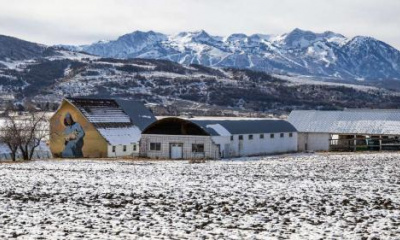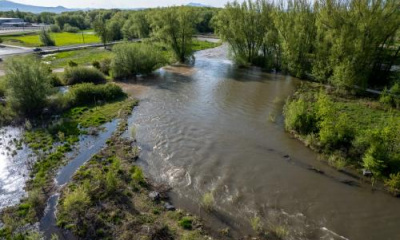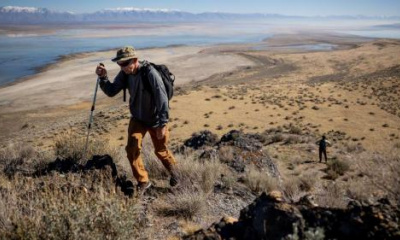SALT LAKE CITY — Deeda Seed and Jonny Vasic are leading a few dozen people through the hallways of the Utah Capitol, to deliver a pair of purple file folders to two Utah Inland Port Authority board directors.
Each folder contains a petition against the port authority's proposal to approve the Golden Spike Inland Port Project Area, a future satellite port for the state's growing inland port system, along with about 1,200 signatures, says Vasic, executive director for Utah Physicians for a Health Environment. After a page quietly accepts one of them, he slides the other folder under the Utah Senate reception room door after there was no answer.
While this group — a mixture of environmental activists in the state — has been vocal about its disapproval of the inland port system since its inception five years ago, it came to the Utah Capitol Thursday morning to raise new concerns about the proposed satellite port activists say will be disruptive to the fragile Great Salt Lake ecosystem because of its proximity to the Bear River Migratory Bird Refuge.
"To put industrial development next to a migratory bird refuge of international and global importance is a terrible idea," says Seed, a senior campaigner for the Center for Biological Diversity. "We're calling on the port authority to not do this."
What is the Golden Spike Inland Port?
The Golden Spike Inland Port calls for sites "clustered" near the interchange connecting Interstate 15 and state Route 13, near Brigham City Municipal Airport, as well as other portions of Box Elder County. Brigham City, Garland and Tremonton county officials approved resolutions earlier this year to establish the project area, inviting the Utah Inland Port Authority to set up operations.
The agency's board of directors is scheduled to meet Monday to make the project official, setting aside space for agriculture, aerospace and other goods to be imported and exported by rail throughout the region, says Ben Hart, executive director at the Utah Inland Port Authority.
"What we've found, especially over the past 10 to 20 years, is that there's a lot of people just putting their cargo on the road and there's an opportunity to help take some of those trucks off the road and put them on rail," he said. "That helps clean our air; it also helps to ensure our freeways aren't totally clogged and also helps boost the local economy."
If approved, it will be the fourth established port site, behind a main center in Salt Lake City and two other satellite ports in Iron and Utah counties.
An environmental debate
Environmental groups disagree on the potential impact of the inland port system, arguing that it increases truck and rail traffic. But in this case, they worry about the Golden Spike project's proximity to the Bear River Migratory Bird Refuge, located at the northeastern edge of the Great Salt Lake and less than a mile from the Brigham City portion of the planned site.
The refuge, established in 1928, is tucked between the Central and Pacific flyways, drawing millions of birds of more than 200 species annually, while nearly 70 species use it for nesting every year, according to U.S. Fish and Wildlife Service, which manages the refuge.
There are also 18 migratory bird species that "warrant special attention" within the project area during the breeding seasons, March 1 through Aug. 31, according to the project area's environmental review.
Environmental groups contend the additional trains and trucks an inland port would attract, may cause demonstrable impacts on the vital portion of the Great Salt Lake ecosystem, which is already struggling from years of drought and overconsumption of water that drains into the lake.
Birds can easily be impacted by disruption to their habitats, says Heather Dove, president of the Great Salt Lake Audubon, pointing to the significant dropoff in pelicans at Gunnison Island on the Great Salt Lake as an example of this. She's concerned that similar impacts will spread to the bird refuge.
"That visual disturbance is going to cause them to, I think, utilize less of the Bear River refuge because that area, for migratory travel, is going to be off-limits for them. They're going to avoid that," she said. "Also, the noise pollution is very disturbing to them. They can't even hear each other communicate, so that's going to make it difficult for their survival, and the light pollution is an issue."
She adds that birds are often the best indicator of a successful ecosystem, meaning if they disappear, it's an indication there's an environmental problem.
The project report, while acknowledging the refuge, is vague about handling environmental concerns, Seed argues. Others who attended a rally held before the petitions were dropped off echoed these concerns and questioned if the project will provide the benefits that the Utah Inland Port Authority promises, citing two state audits published last year that questioned its contracts and planning.
Hart, who assumed his role after the time frame of the audits and led a shakeup of the port system, is confident in the port's future and he's aware of the environmental concerns, saying the port authority will look into ways to mitigate impacts — if and when it approves the project. These include "environmental buffers" between the development and the refuge, possible conservation easements and adjusting lighting so that it's more wildlife-friendly.
The environmental report also recommends construction is completed "outside of the (Birds of Conservation Concern) breeding season."
"Look, if the port's not involved, this is just going to develop out," he said, noting that the area is already zoned for industrial use. "But because the port is involved, it really allows for really a much more conducive development."
Utah Gov. Spencer Cox shrugged off the concerns during his monthly meeting with Utah reporters on Thursday, asserting the port is building away from both the lake and refuge.
"These are places where trains have been before and where trains will continue to go," he said.
An upcoming vote
The Utah Inland Port Authority board of directors is set to vote to formally approve the project during a meeting at Utah State University's Brigham City campus auditorium on Aug. 22. Its members are also scheduled to hold a presentation, press conference and panel discussion following the 2 p.m. meeting.
Those who attended Thursday's rally are calling on board members to vote against the project, or at least move operations farther away from the refuge; however, Hart said it's unlikely the project will be moved anywhere else because of how the land is already zoned. He and Cox said the project is an example of how there is a need to balance economic growth and environmental issues.
"We can balance our environmental interests and our economic interests if we're thoughtful and we're consistent and we have people who are absolutely watching out for this," Hart said. "If we let one totally dominate the other, we're really going to get to a kicking point where we're not going to be able to grow as a state."
Seed and others aren't as convinced.
If the last-minute effort to block the project doesn't work, she said that she hopes more state audits are done to ensure that the project — and the reconfigured port system — is living up to what it's billed as.
"We need to know what ... the added value of these projects are," she said. "They don't explain that at all, it's just broad-stroke language."








